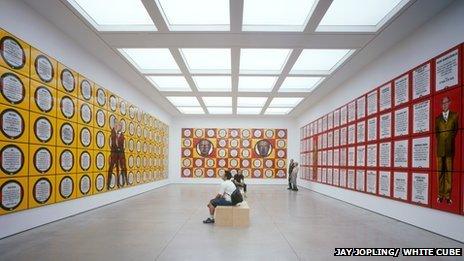East End art scene 'transforms' as White Cube exits
- Published

With news that the White Cube gallery is to close its doors in Hoxton Square, is this the beginning of the end for east London's art scene? Has Shoreditch been ditched?
Perhaps the area reached its zenith of the alternative and frankly bizarre back in the mid-90s when Factual Nonsense gallery owner, the late Joshua Compston, and his pals put on a "Fete Worse than Death".
Held in Hoxton Square, an area surrounded by social housing and derelict warehouses, the fete featured sublime stalls and sideshows.
Provocative artist Tracey Emin hosted a "Rodent Roulette" stand and urban legend has it that you could buy a Damien Hirst spin painting for the princely sum of 50p.
Whoever purchased it must have been laughing all the way to the bank, as the artworks now auction for tens of thousands of pounds.
But it was when art dealer Jay Jopling set up the White Cube in 2000 that Shoreditch transformed almost overnight from edgy fringe to a glossy contemporary art hub.
Young British Artists
From gregarious fashionistas to intrepid graduates from nearby art schools, Hoxton Square was the place to be seen.
A new generation of artists, critics and dealers hung out around gargantuan bins of lager opposite the gallery for its regular openings.
There was an atmosphere of exuberance, aplomb and downright fun.
The gallery was the first to give one-person shows to many of the "YBAs" - Young British Artists who first came to prominence in the late 1980s - and later hosted the likes of Antony Gormley and Gilbert & George.
But now the gallery is pulling out of Hoxton Square to focus on its spaces in central London, Bermondsey in south-east London, and its international galleries in Hong Kong and Sao Paulo.
White Cube's Tim Marlow told the BBC: "Most of the big artists have shown once or twice in the Hoxton spaces.
"After 11 or 12 years at the space, the timing is right and we wanted to get out when on top."
He insisted "east London is still vibrant" and "if there had been a suitable space around the corner from Hoxton, we would have considered it".
But White Cube's move appears to be part of a steady exodus of galleries moving from east London.
Vyner Street, in Bethnal Green, once a stomping ground for aspiring young artists, has also seen many galleries shut up shop in the last year, some of them citing the recession and rising property prices.
'Something different'
Richard Priestley, co-founder of Cell Projects artists studios, on the nearby Cambridge Heath Road, said: "Vyner Street collapsed in on itself.
"A couple of credible spaces set up and then a less rigorous cluster around those bathed in the glory."
Meanwhile, the art scene in Fitzrovia, central London, has seen something of a renaissance, with more than 30 galleries opening in the last four years.
This summer saw the launch of Fitzrovia Lates, an alternative to the East End's First Thursdays, where dozens of galleries open into the night.
Danielle Horn, owner of Nettie Horn gallery, which relocated from Vyner Street to Fitzrovia earlier this year, said: "It's great to be so central. People will just pop in. It's less of an effort."
But many eastenders say their local scene is far from throwing in the towel, and east may simply be becoming a little further east.
Museum of London's Cathy Ross says east London's art scene is "transforming but this is certainly not the end".
"With prices going up, young artists are moving further out to areas like Leytonstone, Barking and Dagenham." she said.
Cell Projects' Mr Priestly said: "We're doing something different, renting out studios to artists in Dalston, Hackney Wick and Clapton.
"We now have over 600 tenants, which generates funding for our exhibitions.
"We find people early in their careers, then curators from institutions and commercial galleries come to shows to look at what we're doing."
Bohemian areas
Shoreditch is not the first place in London to go through this kind of artistic evolution, according to Ms Ross.
"It happened in Hampstead in the 1930s, and Chelsea in the 1950s," she said.
"Rundown, cheap areas, become Bohemian when artists move in.
"Property developers follow, corporate money moves in and an area almost reaches a tipping point becoming less trendy."
But she adds social media "means scenes are being set up more quickly".
"Areas that were once the back and beyond quickly become the main places for people in the know."
Who knows where might be the next hotspot?
- Published8 March 2012
- Published11 October 2011
- Published26 September 2011
- Published22 July 2011
- Published29 May 2009